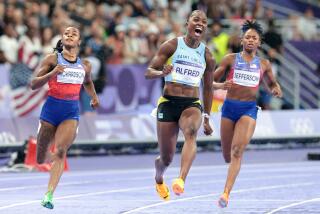From the Archives: Track Olympian Florence Griffith Joyner Dies at 38
Florence Griffith Joyner, who treated a 100-meter stretch of synthetic track as if it were a high-speed fashion runway, breaking world records while wrapped in provocative one-legged lace bodysuits, died in her sleep at her Mission Viejo home early Monday morning. She was 38.
Almost 10 years to the day after her gold-medal triumph in the women’s 100-meter sprint at the 1988 Seoul Olympics, Griffith Joyner was found dead by her husband and former coach, Al Joyner, according to the Orange County Sheriff’s Department.
Department spokesman Lt. Hector Rivera said Joyner placed a 911 call at about 6:30 a.m. to report that his wife was “unresponsive” and had stopped breathing.
“He called for assistance at the home and it was determined that she had died . . . apparently sometime during the night,” Rivera said.
Rivera said the body was taken to the Orange County coroner’s office, where an autopsy was scheduled.
Griffith Joyner had been hospitalized briefly in 1996 after suffering a seizure during a flight from Los Angeles to St. Louis, but Monday, her brother, Weldon Pitts, described that incident as only a “stress” problem.
“She was constantly on the go,” Pitts said. “She was feeling great. There was no indication of any illness. We’re all waiting to see what the coroner’s report says.”
Stunning Olympic Feats
Ten years ago this Friday, Griffith Joyner, nicknamed FloJo, won the first of three gold medals at the Seoul Olympics, running the 100 meters in an Olympic-record 10.54 seconds--two months after having set the women’s world record, 10.49 seconds, at the U.S. Olympic trials in Indianapolis, a mark that has not been challenged since.
Later, Griffith Joyner won gold medals in the women’s 200 meters and 400-meter relay, and a silver medal at 1,600 meters, becoming the first American woman to win four medals in track and field at a single Olympics.
That brief burst of unprecedented sprinting prowess proved a double-edged sword for Griffith Joyner, bringing her international acclaim as “the world’s fastest woman” but also suspicion and innuendo about the possible use of performance-enhancing drugs.
Before the summer of 1988, Griffith Joyner’s fastest time at 100 meters, 10.96, did not rank among the top 40 marks of all time. Her previous personal best at 200 meters, 21.96, was not in the all-time top 20.
But within a span of 10 weeks, Griffith Joyner eclipsed both the 100- and 200-meter records, shattering Evelyn Ashford’s 100-meter mark of 10.76 by an astonishing 0.27 of a second. Her gold-medal 200-meter time of 21.34 was 0.37 of a second lower than the previous world record.
Her gold medals, coming within days of Canadian sprinter Ben Johnson’s expulsion from the games after he tested positive for anabolic steroids, fueled suspicion that Griffith Joyner’s speed might have been chemically enhanced.
Griffith Joyner repeatedly denied all such allegations and never failed a drug test.
“There was a lot of speculation, especially after Ben Johnson got busted,” said Al Franken, a long-time Los Angeles track and field promoter. “But she passed through and never tested positive. You can speculate all you want. No one ever proved anything.
“I think, sadly, that whenever a person achieves that much and breaks a record by so much, people wonder, ‘How could she do that?’ It’s not right to take anything away from the merit of those achievements without having any proof. That’s how you have to look at it.”
Griffith Joyner attributed her rapid improvement to a strict diet and fitness regimen adopted in late 1987 that included daily track workouts and four extensive weight-training sessions a week.
Discussing the drug speculation in 1988, Griffith Joyner conceded that “it hurt me, but it didn’t bother me. I know that I’m a champion. I am anti-drugs. . . . Chasing all those records and giving the young kids coming up something to chase.”
Griffith Joyner relished her title as “world’s fastest woman,” playing the supermodel-in-spikes role to the hilt. Before retiring in 1989, she had gained almost as much notoriety for her skintight body suits and gaudily painted 6-inch fingernails as she had for her remarkable track successes.
“What Florence brought to track was a flash and a flair that we didn’t have, which was probably good for the sport and got attention for us,” said Ashford, her longtime rival.
Primo Nebiolo, the president of the International Amateur Athletic Federation, the governing body of world track and field, said he “will never forget this extraordinary athlete who stunned the world in Seoul 10 years ago with her amazing sprints and spectacular outfits. Sadly, her life has passed as rapidly as her races.”
Devoting Time to Charitable Causes
A Los Angeles native who attended Cal State Northridge and UCLA, where she won NCAA championships at 200 and 400 meters, Griffith Joyner devoted herself in retirement to numerous charitable causes. Most prominent was the Florence Griffith Joyner Youth Foundation for disadvantaged children, which she co-founded with her husband.
She served as co-chairwoman of the President’s Council on Physical Fitness. The White House released a statement from President Clinton on Monday describing Griffith Joyner as “one of our greatest Olympians.”
“We were dazzled by her speed, humbled by her talent and captivated by her style,” Clinton said. “Though she rose to the pinnacle of the world of sports, she never forgot where she came from, devoting time and resources to helping children--especially those growing up in our most disadvantaged neighborhoods--make the most of their own talents.”
Griffith Joyner is survived by her husband and their daughter, Mary Beth, 7. Funeral arrangements are pending.
------------
FOR THE RECORD
In the Sept. 22 obituary of Florence Griffith Joyner, her 7-year-old daughter was identified as Mary Beth. Her name is Mary Ruth.
------------
Times staff writers Scott Martelle and Robert Ourlian contributed to this story.
More to Read
Start your day right
Sign up for Essential California for the L.A. Times biggest news, features and recommendations in your inbox six days a week.
You may occasionally receive promotional content from the Los Angeles Times.






